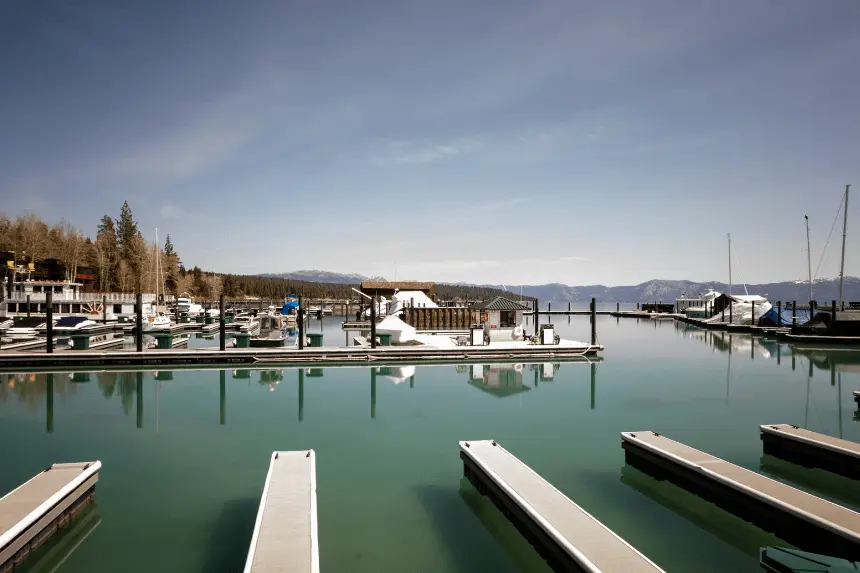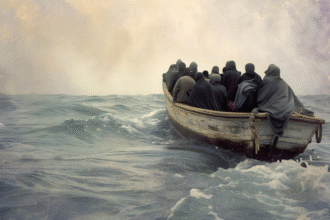A tragic incident unfolded over the weekend as a Lake Tahoe boat accident claimed the lives of six individuals and left two others missing. On Saturday afternoon, a 27-foot Chris-Craft boat capsized near DL Bliss State Park, on the border of California and Nevada. Strong winds and treacherous waves up to 8 feet high battered the lake, catching the vessel in a dangerous swell. This sudden weather shift, coupled with near-freezing temperatures, created a perilous environment for all ten people aboard.
- What brought about the sudden change of weather?
- How Depth and Hazardous is Tahoe Lake?
- Did the Safety Measures exist?
- What is the effect of the Accident on the Environment?
- What is the Police Reaction to the Attack?
- What Can Boaters Take Away from this Tragedy?
- Final Thoughts on the Lake Tahoe Boat Accident
The emergency call reporting a capsized boat came in at around 3:00 PM local time. Rescue teams quickly mobilized, with El Dorado County’s Dive Team and Search and Rescue units scouring the waters for survivors and victims. Although two people were pulled from the icy waters and treated for hypothermia and injuries, six were confirmed dead, and two remain unaccounted for.
What brought about the sudden change of weather?
On Saturday weather conditions on Lake Tahoe changed fast. Huge masses of the waves were flying ahead due to the winds rushing to 35mph, which made navigation highly dangerous. According to weather data, the temperature has dropped severely in the area within a short time and has resulted in rain and even snow in the Sierra Nevada mountain range. The conditions, although not unusual for the high-altitude lake, were swift and aggravated hazards on the waterfront.
According to the experts, the waters of the lake have a very wide surface area, and the location makes it prone to sudden changes in weather. Ships in the open water during such changes are highly likely to capsize, particularly where they are not built to withstand turbulent, abnormal water. This meteorological condition and the geography of the lake were a crucial factor in the tragic incident of Lake Tahoe boat accident.
How Depth and Hazardous is Tahoe Lake?
Tahoe Lake is the biggest alpine lake in North America and also one of the deepest in the world. It has an average depth of 1,000 feet and a maximum depth of more than 1,600 feet, which makes rescue operations unique. The tract between the accident site and one of the rock formations called Roster Rock has more than a 300-foot drop of underwater rock.
These characteristics not only make the underwater exploration and rescue of people difficult, but they also make the risks of boats even higher. In case a ship capsizes in the vicinity of these drop-offs, the victims can easily be swept away to deeper waters at a relatively faster rate, thus largely minimizing the chances of survival. This is a natural feature that made the work of the rescuers difficult in the Lake Tahoe boat accident.
Did the Safety Measures exist?
Other concerns have been brought into question as the investigations have progressed around safety precautions on the ship. The safety departments are yet to establish whether the ten passengers were all carrying life jackets during the accident. Moreover, the operator of this boat did not check the recent weather advisory, presumably.
Although the 27-foot Chris-Craft boat was fine to use recreationally, this boat might not have been in a position to withstand such sudden and severe weather. Authorities are urging safety preparedness in the case of an emergency by having life vests with them, as well as monitoring weather reports and having communication equipment such as radios and flares. Such safety measures are what can spell the difference between life and death, as in the case of the Lake Tahoe boat mishap.
What is the effect of the Accident on the Environment?
Along with the human loss being a purely tragic thing, there are also concerns regarding the environmental impact. Several boats were wrecked during that storm, and some might have lost fuel and oil in the lake. The lake is famed for possessing clean waters, and any form of pollution creates severe ecological hazards.
The situation is being checked now by environmental authorities. In case the oil/gasoline is detected in large amounts, then clean-up activities will be launched to save the aquatic ecosystem. The Lake Tahoe boat accident, therefore does not only leaves the question of safety unanswered, but it also exposes the ecological weaknesses of such natural sites.
What is the Police Reaction to the Attack?
Since the accident, the El Dorado County sheriff’s office and the U.S. Coast Guard, among other federal agencies, have taken part in search and rescue operations. Divers have been used on the suspected crash site and nearby, and helicopters and drones are aiding in exploring it in the air. The hospitals within the area are ready to serve any other survivors.
The identities of the missing people and those who are dead have not been released yet. Cops are collaborating with family members and liaising with different organizations so as to put up a comprehensive probe and rescue operation. The Lake Tahoe boat accident continues to be one of the priorities of the local and federal emergency services.
What Can Boaters Take Away from this Tragedy?
The tragic incident is a strong factor to consider boating safety as an imperative. The weather in alpine areas can vary not only with little notice, but every recreational boater must prepare to face the worst. It is important to go over updated weather conditions and have all safety equipment tested before going out on any water, and more so, a complex body of water like Lake Tahoe.
The operators of the boats have to receive corresponding training and be conscious of the specifics of the lake. Donning of life jackets, application of emergency radio systems, and knowledge of the actions to take when a boat goes upside down a non-negotiable issues. The accident involving a boat in Lake Tahoe is a wake-up call on how fast a recreational trip may be converted into an emergency.
Final Thoughts on the Lake Tahoe Boat Accident
The Lake Tahoe boat accident has left a lasting impact on the community and raised national concerns about boating safety and preparedness. As search operations continue and investigations unfold, the emphasis must now shift toward preventing such incidents in the future. Enhancing weather forecasting systems, enforcing stricter safety regulations, and launching broader public awareness campaigns are crucial steps forward. This tragedy highlights the need to respect nature’s unpredictability, especially on alpine lakes. The beauty of places like Lake Tahoe comes with risk, and that balance must be better understood. Lessons from the Lake Tahoe boat accident should shape stronger safety practices for years to come.








